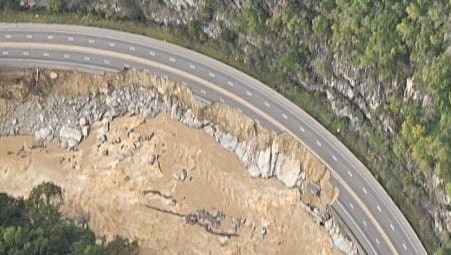
After Hurricane Helene closed almost 40 miles of I-40 in western North Carolina, floodwaters destroying some parts of the major east-west artery, Transportation Secretary Pete Buttigieg said despite the entire government’s best efforts, reopening could take billions of dollars and months or even years.
Previously, NCDOT officials had suggested I-40 might reopen next October, and Tennessee officials noted a temporary fix could turn the interstate into at least a two-lane road.
Buttigieg, joined by North Carolina Gov. Roy Cooper and NCDOT Transport Secretary Joey Hopkins, toured the damaged region of I-40 on Thursday and gave an update on the rescue, recovery and rebuilding efforts. The bulk of the damage took place as eastbound I-40 slid into the Pigeon River, cutting off the major route through the mountains to Asheville. Another stretch of I-40 in east Tennessee also collapsed in the deluge.
Buttigieg said DOT approved an $8 million contract to begin the stabilizing of the slope that collapsed into the Pigeon River, according to local outlet WCMC. Another local outlet, WFMY, reported DOT hopes to stabilize the westbound lanes by January 2025.
“It will take billions of dollars and months, if not years” to get back to normal for the road, Buttigieg said at a press conference posted by WCMC. “We will not rest until that ‘normal’ is available for people in these communities who had their lives upended.”
Buttigieg stressed that DOT would consider how to rebuild in a way that would “make as much sense in 2050 as it would have in 1950” as the region grapples with a level of flooding simply unseen some 700 miles from where the hurricane initially made landfall.
“We’re going to work with engineers to support them in a vision that’s going to work for the future,” he said. “Frankly, we don’t yet know whether the right answer will be to restore things approximately the way things were at this site or if another alignment might be the way forward,” though he stressed an immediate need to reopen roads and get help to communities.
[Related: I-40: Temporary repair in the works]
“We want everybody in the impacted communities to know that we are in it for the long haul,” he said, according to WCMC. “There’s an entire family of federal agencies here to keep President Biden’s promise that we’re here every step of the way.”
Buttigieg said DOT was surveying some 7,000 damage sites and “working to prioritize” which ones to fix first. NCDOT’s Hopkins said the state had more than “500 damaged bridges, but they’re not all out. … We’re looking at probably more than 100 bridge replacements,” but that would have to be sorted in order of priority. Such considerations would include volume of traffic and accessibility to communities impacted by Helene, Hopkins noted.
“Imagine a road that was built 100 years ago and it gets washed out by what is said to be a 100-year flood, and two years later it gets washed out again,” said Buttigieg. “We can keep restoring that road to the exact specifications that made sense 100 years ago, or we can rebuild it on higher ground.
“Our role is to ensure funding isn’t a barrier to finding the answer. It’s one thing to see a photo, it’s another to stand here and look at the shocking, destructive power of the storm. It’s almost impossible to think water and wind alone could have torn apart rock, asphalt and the literal ground where we’re standing.”
NCDOT’s Hopkins said “not rebuilding is not an option. We will rebuild, the question is how.”
The federal government has “rushed federal dollars” to the tune of $100 million in emergency funding for road restoration in North Carolina, Buttigieg said, but the full timeline for the project remained unclear.